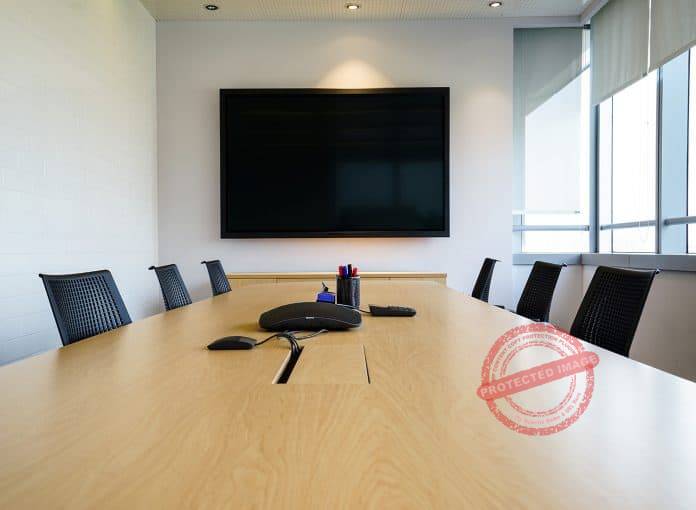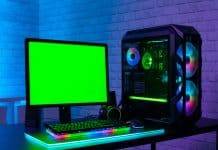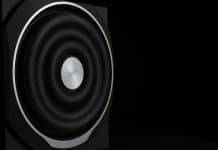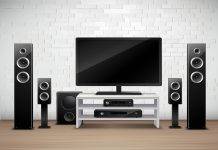We are a participant in the Amazon Services LLC Associates Program, an affiliate advertising program designed to provide a means for sites to earn advertising fees by advertising and linking to amazon.com. As An Amazon Associate We Earn From Qualifying Purchases.
Perhaps you need to show a group of people something at the office but it can’t from your laptop screen or you have a video conference meeting to attend . For this, you need a monitor and this is why we’re looking for the best TV for conference room monitor. From our research and findings, the ✅Samsung 65-Inch BE65T-H Pro TV is the best TV for conference room monitor.
When it comes to finding the best TV for use as a conference room monitor, the normal doesn’t apply.
Your needs and activities change since it is a TV that will be in an office rather than a home.
Best TV for Conference Room Monitor
Things like gaming and watching your favorite soccer team play may not apply to this TV.
Therefore, features that enhance these characteristics can sometimes be even overlooked.
However, we advise that you pay attention to everything – the features you need and those you don’t.
Comparison Table of Best TV for Conference Room Monitor
Tap the images to get your Best TV for Conference Room Monitor on Amazon
How to Identify the Best TV for Conference Room Monitor
Some of the features you should consider as top priority includes;
Screen Resolution
This is one of the most important features as far as getting a conference room monitor is concerned.
Most of the time, we will be either having a lecture, seminar, or watching a random company video.
The resolution of the TV is what shows us the quality of image and graphics the TV can provide.
Screen resolution is measured in pixels (p) and four types have been found in the market in recent times.
The 720p and 1080p are part of the HD tree, the 2160p which is 4K, and 4320p which is 8K.
Based on the value, it is easy to say that the 8K resolution screens are the best and this is true.
Getting an 8K screen at the office will assure you the best quality and detail when passing visual information.
However, we must say that these screens do not come cheap, 8K resolutions screens are the most expensive.
You can still find a 4K resolution screen which is also very good for more decent prices.
This screen resolution is actually our recommended resolution for your conference room monitor.
Although, there are HD screens that provide good quality and are less expensive than the 4K.
We would still recommend the 4K screens as it promises great value for money.
TV Type
When trying to pick out a TV, the first thing you are going to notice is that we have two types of TVs.
A lot of the TVs you will find in the market today are flat screened TVs but a few come with curved screens.
So, you take a look at the conference room and decide which of the screens will fit best into it.
From our research, we would say the flat screen wins this argument ten times out of ten.
This is because when you look at the advantages the curved screen has over the flat ones.
It has little or no significance once the conference room is inputted into the equation.
Curved TVs will always make a 2D image look 3D because it has an illusion of depth.
This will be relevant if we were gaming, watching a nice movie, or even seeing our favorite team play.
This however is not the case as we are going to be doing more professional things in this room.
When you look at the demerits of a curved TV, it makes sense to go with flat ones.
For example, curved TV gives you a good view when you sit in the sweet spot.
Because of the angles of the side, the best view is seen by the person(s) sitting in the middle.
The conference room doesn’t have sitting arrangements that permit everybody to be in the middle.
This is another reason that disqualifies the curved TVs and elevates the status of the flat TV.
Lastly, curved TVs look awkward on the wall and most times the conference room TV ends up on the wall.
So, there is no way you will get a curved TV in when you know it is not wall mount ready.
Screen Type
We are not going to be gaming or watching movies but it doesn’t mean we can do without quality.
Photo, video, and graphics quality from a visual output device are important.
The screen type is basically telling us how the screen was made and determining working conditions for optimum performance.
In recent times, the evolution of TV screens has continued but 4 have stood longer – LCD, LED, QLED and OLED.
The LCD screens are not so popular anymore and this is because users opt for ‘better’ screens.
The LED, QLED, and OLED are the three options left.
QLED stands for quantum dot light-emitting diodes while OLED organic light-emitting diodes.
They both sandwich a panel with the normal LED panel forming a triple-layer screen distraction.
The QLED uses quantum dots are placed before the normal LED screen panel.
For OLED screens, a carbon-like material that produces light when electricity is passed through it is used.
Screen Size
When it comes to getting the best conference, room monitor – size plays an important role.
In a bid to get the best size of TV for you, there are considerations to be made.
One of such will be the question of how many, how many people would watch the screen all at once.
One person or two would normally use an office instead of a conference room for their meeting.
The conference room is used most times when you have a larger number of people coming together.
Meetings, presentations, briefs, and lectures are a few of the activities that may be going on in the room.
Size increases comfortability when the number of eyes increases – so the conference room monitor has to be big.
Another factor to consider is the space available for the TV you are bringing in.
Are the walls going to be wide enough for the size of the TV you have chosen?
If not then going a few inches lower wouldn’t be such a bad idea.
Price and Other Financial Matters
This is what will interest you or your organization the most in your pursuit of a new TV set.
They definitely wouldn’t want to go bankrupt simply because the conference room needs a screen.
So, working out a suitable price range first solves half of your problems in your pursuit of a new TV.
When we talk about price, it goes beyond just looking at the amount you pay to get it home.
There are other ways of making that price even cheaper without necessarily reducing quality.
One sure way to go about it is to make sure the TV you choose is available for free shipping.
Another thing to look out for are products above your price range and value that are available at discount.
There is also something called running cost which is how much you pay to use the TV you bought.
This can be estimated by knowing the energy usage of the TV you have selected.
Luckily for us, TVs especially modern-day ones have very low energy usage.
Sound Technology
The sound technology and levels of the TV to be used as a conference room monitor must be standard.
The conference room is usually no place for a soundbar, home theatre, or any other sound system.
This means whatever sound your TV comes with will be what you use to communicate audio.
There are so many different sound technologies available, some are unique while others are combinations of two or more technologies.
However, the three most common sound technologies are the Dolby Atmos, DTS:X, and Acoustic surface sound.
Acoustic surface Sound technology is used mainly by the Sony brand for their TVs.
Through the use of actuators, they devised a means of converting the screen into a giant speaker.
This way the sound and pictures come directly from the same source and hence give a better viewing experience.
The Dolby Atmos has a low bitrate encoder while the DTS:X has a high one but they both produce quality sound.
However, they both employ audio compression technology in a bid to create surround sound.
Some brands especially Sony combines the Acoustic surface audio with Dolby or DTS:X to form the Acoustic multi-audio technology.
Picture Technology
There are so many technologies available to improve picture graphics and video quality.
One of such is the High-dynamic ranging technology which is available in most smart TVs today.
What the HDR technology does is it reproduces a higher range of luminosity that won’t be possible on a TV without it.
What this means is that features like color, contrast, and brightness are better in an HDR-enabled TV.
There are two main technologies available in newer models of smart TVs – the Dolby vision IQ and Adaptive picture.
They adjust the settings of your screen to fit into your environment whether there is too little or much light.
The Adaptive picture technology is found mostly in Samsung TVs while others use the Dolby vision IQ.
The refresh rate of a TV basically tells you how many times per second the TV refreshes itself.
TVs would need to refresh themselves more than once per second to get more details and avoid blur or lags.
The Backlight feature also helps improve performance when the room has a lot of light penetrating it.
Most conference rooms are found with open views, so the more technology to fight sun glare, the better.
Available Ports and Connectivity
We wouldn’t be worried if the TV doesn’t have an RF cable port here because we might not need it.
However, the information used in a conference room will most time be on a laptop or a flash drive.
This means the important ports will be the HDMI port, VGA port, and USB port for data and information.
However, in a company setting the internet access is usually sourced internally, so an Ethernet cable port is important.
Just to be on the safe side and to be tech-savvy, get a TV that still comes with Wi-Fi connectivity.
7 Best TVs for Conference Room Monitor
1. Samsung 65-Inch BE65T-H Pro TV is the No 1 choice for the Best TV for Conference Room Monitor
The Samsung BE65T-H is the best TV because the conference room is where it was made for.
This commercial TV comes with a crystal 4K process which is a processor with lightning speed.
It has a full array of connectivity – Ethernet cable port, 2 USB port, 2 HDMI ports, Bluetooth, and wireless connection.
This 65-inch smart TV weighs 62.9 pounds and is available in other sizes.
It has dimensions of 11.16” X 57” X 35.63” and is accessible via its mobile app for easy control.
Pros
- A commercial TV with 2 USB ports
- Wi-Fi connectivity and Ethernet cable available.
- Available in other sizes
Cons
- Only 2 HDMI ports available
Purchase the Samsung 65-Inch BE65T-H Pro TV from Amazon by clicking on the image link above
2. Sony X900H 65 Inch TV- 4K Ultra HD Smart LED TV with HDR
The Sony X900H is a 65-inch LED TV that has all it takes to give the best conference room monitor performance.
A refresh rate of 120Hz makes the viewing experience good without lags or blur.
4 HDMI ports are just a start to its wide range of connectivity.
It weighs about 70.9 pounds and has a dimension of 13.38” X 57.13” X 33.63”.
One of the good things about this model is that it is available in other screen sizes.
Pros
- Wi-Fi and Bluetooth enabled
- 4 HDMI ports available
- A refresh rate of 120Hz
- Dolby vision IQ and Atmos available
Get the Sony X900H 65 Inch TV from Amazon by clicking the link
3. SAMSUNG 65-inch Class Crystal UHD TU-8000 Series – UN65TU8000FXZA
This smart Ultra HD TV weighs 45.4 pounds and its dimensions are 13.5” X 49” X 30.88”.
It is equipped with Wi-Fi and Bluetooth and has 2 HDMI ports.
The refresh rate of 60Hz prevents blurs and lags when using the TV.
This smart HDR-enabled LED TV runs on the crystal 4K processor.
The model is available in other sizes just in case the 65-inch model is too small for you.
Pros
- Available in other sizes
- Wi-Fi and Bluetooth enabled TV
Cons
- Only 2 HDMI ports available
Buy the SAMSUNG 65-inch Class Crystal UHD TU-8000 Series – UN65TU8000FXZA on Amazon by clicking the image above
4. LG Electronics 65UK6300PUE 65-Inch 4K Ultra HD Smart TV
This is another big screen that is worth hanging in your conference room for use as a monitor.
The weight measures 45.1 pounds and it has a dimension of 10.6” X 57.8” X 36.1”.
It is an LED screen that runs on a quad-core processor.
A full array of connectivity and ports is led by 3 HDMI ports and 2 USB ports.
This Ultra HD smart TV is both Wi-Fi and Bluetooth enabled.
Pros
- 3 HDMI ports available
- Wi-Fi and Bluetooth enabled
- A refresh rate of 60Hz
Cons
- Not available in other sizes
Own the LG Electronics 65UK6300PUE 65-Inch 4K Ultra HD Smart TV from Amazon by clicking the image link
5. Samsung UN75RU7100FXZA Flat 75-Inch 4K UHD 7 Series
This smart TV runs on the X1 4K Ultra HD processor which is one of the best from Samsung.
It weighs about 82.7 pounds and has a dimension that measures 14” X 66.3” X 41.6”.
The refresh rate of this smart LED TV is 60Hz which is good to fight against blurs and lags.
This 75-inch TV has high usability as it comes with a full array of connectivity led by 3 HDMI ports.
Pros
- It has a refresh rate of 60Hz
- Standard backlight and 4K UHD upscaling
- 3 HDMI ports available
Cons
- Not available in other sizes
Click the image to buy the Samsung UN75RU7100FXZA Flat 75-Inch 4K UHD 7 Series from Amazon
6. TCL 65″ 4-Series 4K UHD HDR – 65S405
The TCL 65S405 is blessed with a full range of connectivity to choose from.
It is Wi-Fi enabled and comes with 3 HDMI ports.
It has a total weight of 45.4 pounds and the dimension measures 9.7” X 57.8” X 35.9”.
This 65-inch TV has a motion rate of 240 and a refresh rate is measured to be 120Hz.
This means we don’t have to worry about blurry pictures, graphics, and videos when using this TV.
Pros
- A refresh rate of 120Hz.
- 3 HDMI ports available
- Available in other sizes
Cons
- Dolby vision IQ not available
By clicking the image link, you buy the TCL 65″ 4-Series 4K UHD HDR – 65S405 from Amazon
7. LG Electronics 55UJ6300 55-Inch 4K Ultra HD Smart LED TV
The LG 75-inch 4K Ultra HD HDR-enabled smart TV weighs 31.5 pounds.
It has 3 HDMI ports and 2 USB ports amongst other ports.
It has a dimension that measures 9.3” X 49.2” X 30.9” and it is Wi-Fi enabled TV.
A motion flow rate of 120, a refresh rate of 60Hz makes it a good screen to work with.
Pros
- The refresh rate is 60Hz
- 3 HDMI available
- Available in other sizes
Cons
- No Dolby vision IQ available
Click the image to purchase the LG Electronics 55UJ6300 55-Inch 4K Ultra HD Smart LED TV from Amazon
Conclusion on the Best TV for Conference Room Monitor
Good size and better picture quality will give you the best conference room TV possible.All things considered; our decision remains the same as it was in the beginning.
The ✅Samsung 65-Inch BE65T-H Pro TV remains our choice for the best TV for conference room monitor.
So, click on the product name now to get yours.
Remember offers are always valid only while stock lasts.
You can also check out more TVs for conference rooms, here.
















